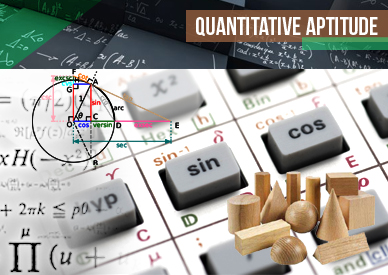Mixture and Alligation : Set 2 for SBI PO
Want to Become a Bank, Central / State Govt Officer in 2020?
Join the Most awarded Coaching Institute & Get your Dream Job


Now Prepare for Bank, SSC Exams from Home. Join Online Coure @ lowest fee
Lifetime validity Bank Exam Coaching | Bank PO / Clerk Coaching | Bank SO Exam Coaching | All-in-One SSC Exam Coaching | RRB Railway Exam Coaching | TNPSC Exam Coaching | KPSC Exam Coaching
Mixture and Alligation : Set 2 for SBI PO
Q.1) A mixture of 70 litres of milk and water contains 20% water. How many litres of water is to be added so that the water may be 30% of the mixture?
a) 70 litres
b) 10 litres
c) 30 litres
d) 20 litres
e) 40 litres
Q.2) From a cask of wine containing 100 litres, 10 litres are drawn out and the cask is filled up with water. If the process is repeated once more, how many litres of wine will be left in the cask?
a) 100 litres
b) 91 litres
c) 80 litres
d) 81 litres
e) 70 litres
Q.3) Two alloys of silver and copper contains silver and copper in the ratio 4:1 and 5:4. What quantities of each should be mixed to prepare silver being 70% of the mixture.
a) 13:9
b) 9:13
c) 7:3
d) 3:7
e) 1:1
Q.4) Two vessels contain milk and water in the ratio 3:2 and 7:2 respectively. In what ratio these are to be mixed to prepare a 3rd mixture containing milk and water in the ratio 2:1?
a) 3:5
b) 5:3
c) 3:2
d) 5:2
e) 2:1
Q.5) Equal amounts of water were poured into two empty jars of different capacities, which made on jars full and the other jar full. If the water in the jar with lesser capacity is then poured into the Jar with greater capacity, then the part of the larger jar filled with water is,
a) 1/4
b) 3/4
c) 2/3
d) 1/12
e) None of these
Q.6) When processing flower nectar into honey, a considerable amount of water is added. How much flower nectar must be processed to yield 1kg of honey, if nectar contains 70% water and the honey obtained from this nectar contains 17% water?
a) 4.11kg
b) 1.76kg
c) 0.36kg
d) 2.77kg
e) None of these
Q.7) Three vessels containing mixtures of milk and water are of capacities which are in the ratio 2:3:4. The ratio of milk and water in the three vessels are 3:2, 4:1 and 3:2 respectively. If one fourth the contents of the first vessel, one- third of that of the second vessel and half of that of the third vessel are mixed, what is the ratio of milk and water in the new mixture?
a) 17 : 23
b) 23: 12
c) 15: 29
d) 1: 2
e) None of these
Q.8) 400gm of salt solution has 60% salt in it. How much salt should be added to make it 40% in the solution?
a) 60gm
b) 80gm
c) 100gm
d) 120gm
e) None of these
Q.9) A container contained 160 litres. From this container 16 litre of Juice was taken out and replaced by water. This process was further repeated two times. How much Juice is now contained in the container?
a) 116.64 litre
b) 154.26 litre
c) 144.23 litre
d) 128.32 litre
e) None of these
Q.10) Vessels A and B contain mixture of milk and water in the ratio 1:4 and 3:2 respectively. In what ratio should quantities of mixture be taken from A and B to form a mixture in which milk to water is in the ratio 2:3?
a) 1 : 5
b) 1 : 1
c) 2 : 1
d) 2 : 3
e) None of these








